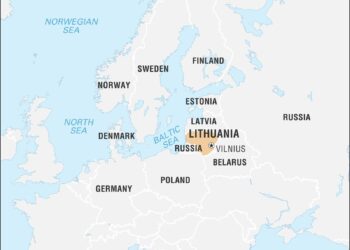Foot-and-Mouth Disease Epidemic: Hungary and Slovakia Take Drastic Measures Amid Outbreak
As concerns over food security and animal health escalate in Europe, the ongoing foot-and-mouth disease epidemic has compelled Hungary and slovakia to undertake unprecedented actions. In a concerted effort to contain the outbreak, authorities in both countries are destroying thousands of animals, raising alarm among agricultural communities and sparking widespread debate on the effectiveness of such measures. Foot-and-mouth disease, a highly contagious viral infection that primarily affects cloven-hoofed animals, poses not only a notable threat to livestock but also has far-reaching implications for the agricultural economy. This article delves into the current situation in Hungary and Slovakia, examining the scale of the crisis, the responses by governments, and the repercussions for farmers and consumers alike.
foot-and-Mouth Disease Epidemic Surge in Hungary and Slovakia
The recent resurgence of foot-and-mouth disease in Hungary and Slovakia has led to severe measures aimed at controlling the outbreak. Authorities are undertaking a systematic culling of affected livestock, with thousands of animals being destroyed to prevent further spread. This unprecedented decision has been made in light of rising infection rates among cattle, pigs, and sheep, causing significant concern within the agricultural community. The situation has not only disrupted local farming practices but has also raised alarms about the potential impact on regional economies dependent on livestock trade.
To ensure effective management and containment of the disease, officials have implemented a series of strict protocols, including:
- Quarantine zones: Establishment of restricted areas around infected farms.
- Monitoring and Surveillance: Increased testing of livestock populations to detect early signs of infection.
- Public Awareness Campaigns: Initiatives aimed at educating farmers about biosecurity measures.
As the situation evolves,the hope remains that coordinated efforts will mitigate the impact of this health crisis on the agricultural sectors in both countries.
Understanding Foot-and-Mouth Disease: Causes and Transmission
Foot-and-mouth disease (FMD) is a highly contagious viral illness that affects cloven-hoofed animals, including cattle, pigs, sheep, and goats. The causative agent of this disease is the foot-and-mouth disease virus (FMDV), which belongs to the Picornaviridae family. The virus is transmitted primarily through direct contact between infected and susceptible animals, but it can also spread indirectly through contaminated environments, feed, or even via aerosol over short distances. Key factors that contribute to the outbreak include:
- High mobility of livestock: Animals can be easily transported, facilitating the rapid spread of the virus.
- environmental stability: The virus can survive for extended periods in feed, soil, and on equipment.
- Inadequate biosecurity measures: Poor quarantine and management practices can exacerbate outbreaks.
Once infected, animals can exhibit symptoms such as fever, blisters on the mouth and feet, and excessive drooling. The disease poses severe threats not only to animal health but also to agricultural economies, as FMD can lead to substantial losses and trade restrictions. Understanding the transmission dynamics is crucial for implementing effective control strategies. Surveillance and rapid response to outbreaks are essential components of any management program. The table below highlights the primary transmission methods and their impacts:
| Transmission Method | Impact |
|---|---|
| Direct contact between animals | Rapid spread among herds |
| Contaminated feed | Extended reach of the virus |
| Aerosol transmission | Potential for outbreaks over large distances |
The Impact of the Outbreak on Local Livestock Industries
The outbreak of foot-and-mouth disease (FMD) in Hungary and Slovakia has sent shockwaves through the local livestock industries, resulting in the necessary culling of thousands of animals to contain the spread. The impact of this action extends beyond the immediate losses; it substantially disrupts the supply chain and threatens the livelihoods of farmers and associated businesses. The decision to eradicate affected livestock not only aims to halt the outbreak but also poses a critical challenge for future herd health and agricultural profitability. Farmers are grappling with emotional and financial strain as they cope with the implications of losing their animals, which represent years of investment and dedication.
As local farmers and industry stakeholders react to the crisis, it is crucial to assess both the short-term and long-term consequences of these drastic measures. Key effects include:
- Market Instability: The large-scale culling has led to increased prices for unaffected livestock,exacerbating economic pressures on farmers still in operation.
- Reduced Production: With fewer animals available, the production of dairy and meat products is highly likely to decline, which may lead to food security concerns.
- Consumer Confidence: The outbreak and subsequent culling may erode consumer confidence in livestock products, potentially affecting sales even after the crisis subsides.
| Factor | Impact on Livestock Industry |
|---|---|
| Animal Culling | Immediate loss of livestock |
| Economic Pressures | increased prices for remaining livestock |
| Disease Spread Control | Long-term effects on herd health |
Mass Culling: A Necessary measure or a Last Resort?
The rapid spread of foot-and-mouth disease (FMD) in Hungary and Slovakia has raised critical questions regarding the practices of mass culling as an immediate response. Authorities argue that this drastic measure is essential to contain outbreaks and protect the broader agricultural ecosystem. In regions where the disease poses a significant threat to livestock, the sacrificing of infected or at-risk animals is viewed as a necessary evil to prevent a widespread catastrophe. Key justifications for mass culling include:
- Stopping the transmission of the disease to uninfected herds.
- Reducing the economic impact on farmers and the agricultural sector.
- Maintaining public health and food safety through rigorous disease control.
Though, this approach is fraught with ethical dilemmas and economic consequences that cannot be overlooked. The emotional and financial toll on farmers, who often view their livestock as part of their family, creates a complex landscape of frustration and moral questioning.There are voices advocating for choice strategies that emphasize vaccination and improved biosecurity measures. Some have suggested that instead of resorting to culling, resources should be allocated towards enhancing disease surveillance systems and developing a more robust veterinary infrastructure. The debate continues, challenging the balance between swift action in the face of an outbreak and sustainable practices that promote animal welfare and economic viability.
Government Response: Policies and Strategies in Place
In response to the escalating foot-and-mouth disease epidemic affecting both Hungary and Slovakia,government authorities have implemented a series of stringent measures aimed at containing the outbreak. The primary strategy involves the culling of infected livestock to prevent further transmission. Farmers are being reimbursed for their losses and provided with guidelines on biosecurity practices.This initiative includes:
- Enhanced surveillance of livestock health to identify potential cases early
- strict transportation regulations to limit movement of animals from infected regions
- Collaboration with veterinary organizations to improve vaccination protocols
Authorities are also launching public awareness campaigns to educate farmers and the general population about best practices during this crisis. As part of these efforts, the government has established an emergency response team dedicated to address and mitigate the impacts of the disease. Key components of this strategy include:
| Action | Description |
|---|---|
| Field Inspections | Regular checks of farms to monitor the health status of livestock. |
| Facts Dissemination | Providing farmers with real-time updates and guidelines via SMS and social media. |
| Research Initiatives | Funding studies to enhance understanding of the disease and improve vaccine growth. |
The Role of Veterinary Services in Controlling the Outbreak
Veterinary services play a critical role in managing and mitigating the consequences of outbreaks like the current foot-and-mouth disease epidemic. Their responsibilities encompass a range of activities essential for effective disease control, including:
- Surveillance and Monitoring: Continuous monitoring of livestock populations helps in early detection of the disease, allowing for prompt action.
- Vaccination Programs: Implementation of vaccination campaigns is crucial to build herd immunity and prevent the spread of the virus.
- Epidemiological Assessment: Veterinary experts analyze data to determine patterns and risks associated with the outbreak, guiding containment strategies.
In response to the current crisis, veterinary services are also involved in the humane culling of infected animals to limit further transmission. This grim yet necessary action is accompanied by stringent biosecurity measures designed to safeguard unaffected herds. Collaborative efforts between veterinarians, government bodies, and agricultural organizations are essential for establishing effective communication channels to inform farmers and the public about preventive actions and best practices, including:
- Education and Training: Providing resources and guidance to farmers on recognizing symptoms of infection.
- Quarantine Procedures: Enforcing strict guidelines to isolate affected farms and minimize contact with healthy livestock.
- Reporting Systems: Establishing clear lines of communication for reporting suspicious cases, which is vital for a swift response.
Public Health Concerns: Risks for Human Populations
as the foot-and-mouth disease outbreak escalates in Hungary and Slovakia, the consequences extend beyond the immediate impact on livestock. The disease poses significant risks to human health and the broader ecosystem. While the virus primarily affects cloven-hoofed animals, including cattle and pigs, its potential for zoonotic transmission raises alarm bells within public health circles. Human populations,notably those working in agriculture and animal husbandry,are at an increased risk of exposure. Moreover, the economic ramifications of culling thousands of animals can disrupt local food supplies, leading to food insecurity, malnutrition, and heightened stress on healthcare systems already strained by other public health challenges.
Long-term implications of disease outbreaks like these are multifaceted and can include:
- The emergence of antibiotic-resistant pathogens.
- Increased stress and anxiety among agricultural workers.
- Potential reduction in livestock productivity.
- Heightened surveillance and control measures that coudl divert resources from other health initiatives.
To address these challenges effectively, a coordinated response is crucial. Efforts should include robust vaccination strategies,increased public awareness campaigns,and international collaboration to monitor and control such diseases.The situation underscores the intrinsic connection between animal health, human health, and environmental stability, highlighting the importance of adopting a One Health approach.
Economic Implications of the Epidemic for Farmers and Traders
The outbreak of foot-and-mouth disease in Hungary and Slovakia has significant economic implications for both farmers and traders. As thousands of animals are culled to contain the spread of the disease, affected farmers face immediate financial losses due to the destruction of livestock. This situation exacerbates existing challenges, including rising operational costs and potential market fluctuations. The following factors are particularly impactful:
- Loss of Income: Farmers lose their primary source of revenue when livestock is culled, leading to cash flow issues.
- increased Operational Costs: Additional expenditure is incurred for biosecurity measures and rebuilding herds post-outbreak.
- market Instability: The reduction in livestock supply may lead to increased prices, impacting both consumers and traders.
Moreover, traders are also feeling the pressure as supply chains become disrupted due to ongoing quarantine measures and transportation restrictions. The immediate effect of the epidemic not only threatens individual livelihoods but also the broader agricultural economy.A ripple effect can be seen across various sectors,including:
- Feed Suppliers: A decrease in livestock reduces demand for feed,threatening agribusinesses reliant on consistent sales.
- Export Opportunities: Both Hungary and Slovakia may face trade bans, limiting their market access and potential international trade relationships.
- Consumer Confidence: Ongoing disease outbreaks can lead to consumer hesitation regarding meat purchases, further straining the market.
| Impact Category | Effect on Farmers | Effect on Traders |
|---|---|---|
| Income Loss | immediate revenue decline | Reduced sales volume |
| Operational Costs | Increased spending on biosecurity | Higher logistics costs |
| Market Stability | Price volatility in livestock | Shifts in supply-demand balance |
International Response: How Neighboring Countries Are Reacting
In the wake of the foot-and-mouth disease outbreak affecting livestock in Hungary and Slovakia, neighboring countries have exhibited a range of responses aimed at containing and preventing the spread of the disease.Poland has heightened its border inspections, ensuring that livestock movements are carefully scrutinized. Austria has implemented a temporary ban on the import of cattle from affected regions, while Czech Republic authorities are engaging in emergency meetings to evaluate their biosecurity measures. The agricultural ministries of these nations are coordinating efforts to monitor animal health, with exchanges of information on infection rates and containment strategies.
Local farmers are facing significant challenges as the crisis unfolds, leading to increasingly urgent calls for government assistance across the region. Many ranchers fear for their livelihoods, prompting government aid programs designed to support those impacted by the disease. A breakdown of the measures includes:
- Compensation packages for farmers who must cull infected animals.
- Increased funding for veterinary services and resources.
- Public awareness campaigns to educate communities on preventative measures.
In addition, to ensure a unified approach, a multi-national task force consisting of veterinary experts from the affected neighboring countries is being established to facilitate a coherent strategy in disease management. This collaborative effort aims to establish a more rigorous framework for monitoring livestock health, ultimately reducing the risk of further outbreaks.
Preventive Measures: Best Practices for Livestock Owners
To mitigate the risk of foot-and-mouth disease, livestock owners must adopt a series of proactive strategies that enhance biosecurity on their farms. Regular vaccinations are crucial; ensuring that all susceptible animals are vaccinated according to veterinary recommendations can significantly reduce the likelihood of infection. In addition, establishing strict biosecurity measures such as controlled access to livestock areas, washing and disinfecting equipment, and maintaining a clean environment are essential practices. It is also vital to reduce contact with wild animals, which can serve as reservoirs for the virus.
Moreover, monitoring animal health should be a top priority. Early detection of any symptoms associated with foot-and-mouth disease—such as lesions, excessive drooling, and lameness—can lead to swift action that prevents further spread within a herd. Implementing a disease management plan that includes training for staff on recognizing early signs of illness and understanding protocols for reporting suspicious cases can make a significant difference. Below is a simple table outlining key preventive measures for livestock owners:
| Preventive Measure | Description |
|---|---|
| Vaccination | Regular vaccination of livestock against foot-and-mouth disease. |
| Biosecurity | Implement strict measures to control access and movement within farm boundaries. |
| Health Monitoring | Consistent observation of livestock for early signs of foot-and-mouth disease. |
| Education and Training | Provide training for workers on disease recognition and reporting protocols. |
Future Outlook: Steps to Prevent Recurrence of Foot-and-Mouth Disease
In light of the recent outbreak of foot-and-mouth disease in Hungary and Slovakia, it is crucial to adopt comprehensive strategies aimed at preventing further occurrences. Implementing robust veterinary surveillance systems is paramount,as they allow for the early detection of the disease and enable prompt containment measures. Key actions can include:
- Regular livestock monitoring: Enhancing routine health checks to identify signs of illness swiftly.
- Biosecurity measures: Ensuring that farms are equipped with strict protocols to mitigate contagion risks, such as limiting access and disinfecting equipment.
- Vaccination campaigns: Establishing regional immunization efforts to protect livestock from potential outbreaks.
- Public awareness programs: Educating farmers and communities about the disease, its symptoms, and preventive measures.
Equally vital is the collaboration among government agencies, veterinary authorities, and international organizations. Providing farmers with financial assistance and resources to support compliant practices will foster a culture of proactive disease management. A coordinated response plan must focus on:
- Research and development: Investing in studies that improve understanding of the disease transmission and ways to enhance vaccine effectiveness.
- Emergency response training: Equipping handlers with the knowledge and skills to respond rapidly to any identified outbreaks.
- Data sharing platforms: Implementing systems to facilitate the exchange of information regarding disease status across borders.
| Action | Expected Outcome |
|---|---|
| Enhanced Surveillance | Early detection of outbreaks |
| Public Education | Increased awareness and compliance |
| Research Funding | Development of effective vaccines |
| Regional Partnerships | Stronger collaborative response efforts |
Call to Action: Support for Affected Farmers and Communities
The devastating impact of the foot-and-mouth disease outbreak is clear,with thousands of animals being culled in Hungary and Slovakia,leaving farmers and communities in dire need of support. As the situation evolves, it becomes imperative for individuals, businesses, and organizations to step up and lend a helping hand. Here are some ways you can contribute:
- Donate to Relief funds: Financial contributions can significantly aid affected farmers in rebuilding their operations and dealing with immediate losses.
- Volunteer Your Time: Whether locally or abroad, volunteering on farms or with organizations providing support can make a tangible difference.
- Spread Awareness: Share stories and information about the impact of the outbreak to encourage a broader community response and support.
Moreover, collaboration is key. Government and non-government organizations must join forces to provide comprehensive assistance packages tailored to the unique needs of affected farmers. The table below outlines potential support measures that could be implemented:
| Support Measure | Description |
|---|---|
| Financial Grants | Direct financial assistance to cover immediate expenses and loss of income. |
| Livestock Replacement Programs | Providing farmers with replacement animals to help restart their businesses. |
| Health Support | Mental health resources and counseling for affected farmers dealing with stress and trauma. |
In Summary
the ongoing foot-and-mouth disease epidemic in Hungary and Slovakia has forced authorities to make difficult decisions, including the culling of thousands of animals to contain the outbreak. This preventive measure underscores the gravity of the situation and the urgency with which the governments of both countries are responding to protect their national livestock and the broader agricultural economy.as the situation unfolds, it is indeed crucial for farmers, veterinarians, and public health officials to remain vigilant and proactive in their efforts to prevent further spread of this contagious disease. Continued monitoring and robust biosecurity measures will be key to mitigating the impact of the epidemic and ensuring the health and safety of livestock across the region. The agricultural communities, alongside governmental agencies, must work collaboratively to navigate the challenges posed by this outbreak and safeguard their futures. As the situation develops, the commitment to transparency and timely reporting will remain essential in keeping both the public and the agriculture sector informed.











